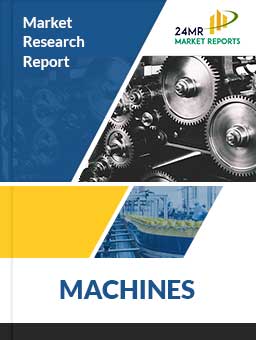
COMPANIES COVERED
?stbergDownload FREE Report Sample
Download Free sampleEnergy Recovery Ventilator (ERV) Units are mechanical ventilation systems designed to enhance indoor air quality by exchanging stale indoor air with fresh outdoor air while minimizing energy loss. ERVs are typically integrated with HVAC ductwork and operate using two fans—one for intake and one for exhaust. What differentiates ERVs from standard ventilation systems is their ability to transfer both heat and humidity between incoming and outgoing air streams, making them energy-efficient solutions for commercial, residential, and industrial applications.
ERV units play a pivotal role in maintaining indoor air quality, reducing energy consumption, and ensuring regulatory compliance with energy efficiency standards. They are especially beneficial in tightly sealed buildings where natural ventilation is limited, and managing temperature and humidity is crucial.
Market Size
Global Energy Recovery Ventilator (ERV) Units market was estimated at USD 3447.90 million in 2024 and is projected to reach USD 6392.34 million by 2032, registering a CAGR of 7.10% during the forecast period.
North America Market
North America, the ERV units market reached an estimated size of USD 1011.10 million in 2024 and is expected to grow at a CAGR of 6.09% from 2025 to 2032.
To know more about market statistics, Download a FREE Sample copy
This growth is largely driven by increasing awareness of indoor air quality, strict energy efficiency regulations, and adoption in residential retrofitting and new commercial constructions.
Factors contributing to this growth include:
Rising energy costs encouraging energy-saving HVAC solutions
Government incentives for green building technologies
Health concerns promoting better indoor air circulation
Market Dynamics (Drivers, Restraints, Opportunities, and Challenges)
Drivers
Increased Focus on Indoor Air Quality (IAQ): Post-COVID-19, there is heightened awareness about ventilation, especially in commercial spaces, educational institutions, and residential buildings.
Energy Efficiency Regulations: Stringent building codes and energy performance standards across Europe, North America, and parts of Asia-Pacific are fueling adoption.
Urbanization and Smart Buildings: Demand for HVAC upgrades in smart homes and urban developments is pushing the demand for ERVs.
Climate Adaptability: ERVs provide a reliable way to manage ventilation while reducing energy bills in both hot and cold climates.
Restraints
High Initial Installation Cost: While they offer long-term savings, ERVs involve significant upfront investment in equipment and installation.
Complex Retrofitting: Integration with older HVAC systems or in constrained spaces poses technical and cost challenges.
Maintenance Requirements: Frequent filter replacements and maintenance are necessary to retain optimal performance, which can be a deterrent.
Opportunities
Integration with Renewable Energy Systems: The compatibility of ERVs with solar and geothermal HVAC systems offers promising synergies.
Technological Advancements: Innovations like smart controls, IoT integration, and automated airflow adjustment open new market avenues.
Expansion into Emerging Economies: Countries in Asia-Pacific, Latin America, and the Middle East are focusing on green infrastructure, creating significant growth potential.
Challenges
Lack of Awareness in Developing Regions: The benefits of ERV systems are not well-known in many regions, impacting demand.
Supply Chain Disruptions: Material shortages and logistical issues, especially post-pandemic, can delay projects.
Competition from Alternative Systems: Competing technologies like HRVs (Heat Recovery Ventilators) may pose market cannibalization challenges in some regions.
Regional Analysis
North America
Europe
Asia-Pacific
South America & Middle East & Africa (MEA)
Competitor Analysis (in brief)
The ERV market features intense competition with both multinational conglomerates and regional players offering tailored solutions.
Panasonic, Daikin, and Mitsubishi Electric dominate the APAC region.
Carrier, Johnson Controls, and Trane have a strong foothold in North America.
Zehnder and Systemair lead in the European market, focusing on eco-design and compliance.
Emerging companies like Renewaire and Airxchange Inc. focus on innovative, compact, and energy-efficient models.
Key strategies include M&A, smart technology integration, and geographical expansion.
Global Energy Recovery Ventilator (ERV) Units Market: Market Segmentation Analysis
Energy Recovery Ventilator Units Market provides a deep insight into the global Energy Recovery Ventilator (ERV) Units market, covering all its essential aspects. This ranges from a macro overview of the market to micro details of the market size, competitive landscape, development trend, niche market, key market drivers and challenges, SWOT analysis, value chain analysis, etc.
The analysis helps the reader to shape the competition within the industries and strategies for the competitive environment to enhance the potential profit. Furthermore, it provides a simple framework for evaluating and assessing the position of the business organization. The report structure also focuses on the competitive landscape of the Global Energy Recovery Ventilator (ERV) Units Market. Energy Recovery Ventilator Units Market introduces in detail the market share, market performance, product situation, operation situation, etc., of the main players, which helps the readers in the industry to identify the main competitors and deeply understand the competition pattern of the market.
In a word, Energy Recovery Ventilator Units Market is a must-read for industry players, investors, researchers, consultants, business strategists, and all those who have any kind of stake or are planning to foray into the Energy Recovery Ventilator (ERV) Units market in any manner.
Market Segmentation (by Application)
Market Segmentation (by Type)
Key Company
Geographic Segmentation
FAQ Section
What is the current market size of Energy Recovery Ventilator (ERV) Units?
Which are the key companies operating in the Energy Recovery Ventilator (ERV) Units market?
What are the key growth drivers in the Energy Recovery Ventilator (ERV) Units market?
Which regions dominate the Energy Recovery Ventilator (ERV) Units market?
What are the emerging trends in the Energy Recovery Ventilator (ERV) Units market?
Key Benefits of This Market Research:
Industry drivers, restraints, and opportunities covered in the study
Neutral perspective on the market performance
Recent industry trends and developments
Competitive landscape & strategies of key players
Potential & niche segments and regions exhibiting promising growth covered
Historical, current, and projected market size, in terms of value
In-depth analysis of the Energy Recovery Ventilator (ERV) Units Market
Overview of the regional outlook of the Energy Recovery Ventilator (ERV) Units Market:
Key Reasons to Buy this Report:
Access to date statistics compiled by our researchers. These provide you with historical and forecast data, which is analyzed to tell you why your market is set to change
This enables you to anticipate market changes to remain ahead of your competitors
You will be able to copy data from the Excel spreadsheet straight into your marketing plans, business presentations, or other strategic documents
The concise analysis, clear graph, and table format will enable you to pinpoint the information you require quickly
Provision of market value data for each segment and sub-segment
Indicates the region and segment that is expected to witness the fastest growth as well as to dominate the market
Analysis by geography highlighting the consumption of the product/service in the region as well as indicating the factors that are affecting the market within each region
Competitive landscape which incorporates the market ranking of the major players, along with new service/product launches, partnerships, business expansions, and acquisitions in the past five years of companies profiled
Extensive company profiles comprising of company overview, company insights, product benchmarking, and SWOT analysis for the major market players
The current as well as the future market outlook of the industry concerning recent developments which involve growth opportunities and drivers as well as challenges and restraints of both emerging as well as developed regions
Includes in-depth analysis of the market from various perspectives through Porters five forces analysis
Provides insight into the market through Value Chain
Market dynamics scenario, along with growth opportunities of the market in the years to come
6-month post-sales analyst support
Customization of the Report
In case of any queries or customization requirements, please connect with our sales team, who will ensure that your requirements are met.
Chapter Outline
Chapter 1 mainly introduces the statistical scope of the report, market division standards, and market research methods.
Chapter 2 is an executive summary of different market segments (by region, product type, application, etc), including the market size of each market segment, future development potential, and so on. It offers a high-level view of the current state of the Energy Recovery Ventilator (ERV) Units Market and its likely evolution in the short to mid-term, and long term.
Chapter 3 makes a detailed analysis of the market's competitive landscape of the market and provides the market share, capacity, output, price, latest development plan, merger, and acquisition information of the main manufacturers in the market.
Chapter 4 is the analysis of the whole market industrial chain, including the upstream and downstream of the industry, as well as Porter's five forces analysis.
Chapter 5 introduces the latest developments of the market, the driving factors and restrictive factors of the market, the challenges and risks faced by manufacturers in the industry, and the analysis of relevant policies in the industry.
Chapter 6 provides the analysis of various market segments according to product types, covering the market size and development potential of each market segment, to help readers find the blue ocean market in different market segments.
Chapter 7 provides the analysis of various market segments according to application, covering the market size and development potential of each market segment, to help readers find the blue ocean market in different downstream markets.
Chapter 8 provides a quantitative analysis of the market size and development potential of each region from the consumer side and its main countries and introduces the market development, future development prospects, market space, and capacity of each country in the world.
Chapter 9 shares the main producing countries of Energy Recovery Ventilator (ERV) Units, their output value, profit level, regional supply, production capacity layout, etc. from the supply side.
Chapter 10 introduces the basic situation of the main companies in the market in detail, including product sales revenue, sales volume, price, gross profit margin, market share, product introduction, recent development, etc.
Chapter 11 provides a quantitative analysis of the market size and development potential of each region during the forecast period.
Chapter 12 provides a quantitative analysis of the market size and development potential of each market segment during the forecast period.
Chapter 13 is the main points and conclusions of the report.

Speak to our Custom Research Team and get the Custom Research in a budget
Custom ResearchFrequently Asked Questions ?
A license granted to one user. Rules or conditions might be applied for e.g. the use of electric files (PDFs) or printings, depending on product.
A license granted to multiple users.
A license granted to a single business site/establishment.
A license granted to all employees within organisation access to the product.
Upto Working 24 to 48 hrs
Upto 72 hrs max - Weekends and Public Holidays
Online Payments with PayPal and CCavenue
Wire Transfer/Bank Transfer
Hard Copy



 Industry Market Size
Industry Market Size SWOT Analysis
SWOT Analysis Industry Major Players
Industry Major Players Revenue Forecasts
Revenue Forecasts Historical and Forecast Growth
Historical and Forecast Growth Profitability Analysis
Profitability Analysis
























